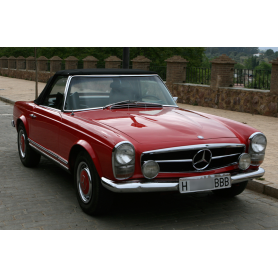No products
Prices are tax excluded
Detailed privacy of the user registry: Here
Legal notice and detailed cookies policy. By continuing to use the site, you accept our use of cookies: Find out more.
166.1
Refurbished
Year of manufacture: 1969
Km 69467.
Restorations or repairs: I take the engine to pulio and wiped 2008 .It was painted in 2008
Type of change: automatic
Attached hood rigid
This product is no longer in stock
Warning: Last items in stock!
Availability date:

MERCEDES PAGODA. 280. 1969.
Year of manufacture: 1969
Km 69467.
Restorations or repairs: I take the engine to pulio and wiped 2008 .It was painted in 2008
Type of change: automatic
Attached hood rigid
Recipient :
* Required fields
or Cancel
| State | SOLD |
MERCEDES 280
The SL 280 was introduced in December 1967 and continued in production until the February 23, 1971, when the 113 W was replaced by its successor, the entirely new and heavier substantially R107 350 SL. Over the years, the 113 W gone from being a sports car in a gran turismo comfortable, and the models of US were by then usually equipped with the 4-speed automatic transmission and air conditioning. Manual transmission models comes with the standard 4-speed or the optional ZF 5-speed, which was ordered only 882 cars and, therefore, today is a very sought after option-original. In Europe, manual transmissions without air conditioning were still the priority choice. Of the 23 885 280 SL produced, more than half were sold in the U.S.
The main change was an update of the 2778 cc (2,8 L) engine M130 with 170 HP (130 kW; 170 HP) maximum power and 180 lb · foot (244 N · m) of maximum torque, which finally gave it enough power W 113 . The performance improvement was achieved by drill growing by 4.5 mm (0.2 in), which stretched the limits of the block of M180, and molds of cylinders required by couples without cooling water passages. This mandate of a oil cooler, which is fitted vertically to the side of the radiator. Each engine was now bench-tested for two hours prior to your installation, so that the power specification was guaranteed at last.
Since some time ago, the M130 was also used in the W109 300 S-Class, where it retired the expensive 3 liter M189 alloy inline six. The M130 marked the final evolution of the venerable M180 SOHC inline six, before it was replaced by the entirely new DOHC M110 inline six introduced with R107 1974 280 european models SL.
A brief chronology of the most notable changes made to the 280SL:
12/1967: One piece wheel-covers (like the sedans of 108 W).
10/1968:. Models of the united States with headlights sealed beam without fog lamps
02/1969: New rear lights with flashing amber .
07/1969: models of the united States with power all solid-state and emission control improved.
08/1969: heated Rear window, rear lights, hard top danger for all models, master key only for all locks. The models of the united States with the optical group with full amber lower section, and the luminous markers on the side.
04/1970:. Bosch Lichteinheit optionally with halogen headlamps main (distinguished by "flat" instead of "bubble" lens)
08/1970:. Alloy wheels from Fuchs available as a factory installed option
11/1970: Opaque coolant expansion tank plastic color beige (instead of black satin, steel). New door locks: cylinder can be depressed while the door is closed and locked.
North american models
1969 Mercedes-Benz 280 SL, US model (050G white). The ceiling is what inspired the "pagoda" nickname.
North american models have a number of subtle differences, the most obvious one being the distinctive "sealed beam headlights with bulbs required in the US versus the Bosch Lichteinheit beacons for the rest of the world, models 1970 the united States also acquired amber turn - lens signal in the rear lights, later than most other countries.
Other differences of the models of North America, which include indicators, imperial guards chrome bumper reflectors (illuminated from 1970), the reduction ratios of the rear axle for faster acceleration yet lower speeds, and there is no "one side" parking lights. Us market 280 engines require modifications SL for the control of emissions, including times "softer" valve, a compression ratio reduced and a modified fuel-injection pump, which reduced power from 170 HP (130 kW 170 HP) to 160 kW (120 PS, 160 HP) .In the US, automatic transmission, air conditioning, and tire white wall were much more popular than in other places.
European cars were popular as the united States imports the grey market: the vehicles were brought to the U.S. a few years after its original delivery in Europe. The first european imports were lights on the market of accessories of danger and safety belts installed Kangol, US safety requirements that were adopted in Europe only in the later years of production.
Special versions
Pininfarina Coupe
While the original design by Paul Bracq is regarded as a masterpiece today, it was more controversial at the time of its introduction. So, in 1963, Pininfarina asked the Board of Mercedes-Benz to produce their own custom-body version of the SL 230. Tom Pininfarina Tjaarda turned the roadster into a coupé head-fixed that vaguely resembled the Ferrari 250 GT Lusso. He retained the grille and headlamps of the original, but it went on the grille more sharply, sculpted the wings, and made the sides larger and broader, therefore, at the time that the engine hood narrower and shorter. The rear was reminiscent of the Ferrari 330 GT 2 +2 (also a Tjaarda design), but without taking away the distinctive personality of the SL 230.In the interior, the dashboard Tjaarda left without changes, but the inside as well as exudes all the hallmark of crafts elegant hand of Italian. The result was attractive, but not compelling enough to go into production and remained a one-time, subsequently acquired by German press baron Axel Springer.
No customer reviews for the moment.